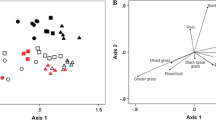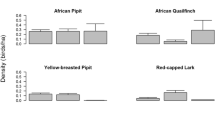Abstract
We investigated the densities of the Redwing Francolinus levaillantii and Greywing Francolins F. africanus and the diversity of grassland birds in general along a land-use gradient in the highlands of Mpumalanga province, South Africa. Redwing Francolins cannot tolerate intensive grazing and frequent burning and are confined largely to unburnt, ungrazed grasslands. Their density and the species richness of grassland birds in general are negatively correlated with grazing intensity. Redwing populations drop to densities that cannot be utilised by hunters on a sustainable basis in grasslands that are grazed at even moderate levels or burned annually. Nineteen bird species (including five threatened species) were confined to essentially pristine grassland and were never observed in grazed/annually burned grasslands. The Greywing Francolin is more evenly distributed (although always at sub-utilisation densities) along the grassland land-use gradient, and its density is positively correlated with grazing intensity. There are two assemblages of grassland bird species that appear to be indicative of the intensity of habitat utilisation. Populations of grassland birds in the study area are becoming increasingly dependent on isolated patches of pristine grassland and are threatened by management involving annual burning and high stocking rates on a landscape scale.
Similar content being viewed by others
References
Acocks JPH (1988) Veld types of South Africa, 3rd ed. Memoirs of the Botonical Survey of South Africa 57
Allan GA, Harrison JA, Navarro RA, Van Wilgen W and Thompson MW (1997) The impact of commercial afforestation on bird populations in Mpumalanga Province, South Africa - insights from bird-atlas data. Biological Conservation 79: 173–185
Anon (1986) Statgraphics: Statistical Graphics System. Plus Ware Products, Maryland
Baines D (1991) Factors contributing to local and regional variation in black grouse breeding success in northern Britain. Ornis Scandinavica 22: 264–270
Baines D (1996) The implications of grazing and predator management on the habitats and breeding success of black grouse Tetrao tetrix. Journal of Applied Ecology 33: 54–62
Berry MPS and Crowe TM (1985) Effects of monthly and annual rainfall on game bird populations in the northern Cape Province, South Africa. South African Journal of Wildlife Research 15: 69–76
Bond WJ (1997) Fire. In: Cowling RM, Richardson DM and Pierce SM (eds) Vegetation of Southern Africa, pp 421–446. Cambridge University Press
Bray JR and Curtis JT (1957) An ordination of the upland forest communities of southern Wisconsin. Ecological Monographs 27: 325–449
Bredekamp G, Granger E and van Rooyen N (1996) North-eastern mountain grassland. In: Low AB and Rebelo AG (eds) Vegetation of South Africa, Lesotho and Swaziland, pp 46–47. Department of Environmental Affairs and Tourism, Pretoria
Brooke RK (1984) South African Red Data Book - Birds. South African National Scientific Programmes Report, No. 97. Foundation for Research and Development, Pretoria
Cody ML (1993) Bird diversity components within and between habitats in Australia. In: Ricklefs RE and Schluter D (eds) Species Diversity in Ecological Communities: Historical and Geo-graphical Perspectives, pp 147–158. University of Chicago Press
Cowling RM and Hilton-Taylor C (1994) Patterns of plant diversity and endemism in southern Africa: an overview. Stelitzia 1: 31–52
Downing BH (1978) Environmental consequences of agricultural expansion in South Africa since 1850. South African Journal of Science 74: 420–422
Edwards PJ (1981) Sour grassveld. In: Tainton NM (ed) Veld and Pasture Management in South Africa, pp 395–399. Shuter & Shooter in association with University of Natal Press
Erdelen M (1984) Bird communities and vegetation structure: I. Correlations and comparisons of simple and diversity indices. Oecologia (Berlin) 61: 277–284
Folse LJ Jr (1982) An analysis of avifauna-resource relationships on the serengeti plains. Ecological monographs 52: 111–127
Hanski I and Gilpin M (1991) Metapopulation dynamics: brief history and conceptual domain. Biological Journal of the Linnaean Society 42: 3–16
Happold DCD (1995) The interactions between humans and mammals in Africa in relation to conservation: a review. Biodiversity and Conservation 4: 395–414
Harrison JA, Allan DG and van Hensbergen HJ (1994) Automated habitat annotation of bird species lists - an aid in environmental consultancy. Ostrich 65: 316–328
Hockey PAR, Allan DG, Rebelo AG and Dean WRJ (1988) The distribution, habitat requirements and conservation status of Rudd's Lark Heteromirafra ruddi in South Africa. Biological Conservation 45: 255–266
Hurlburt SH (1971) The nonconcept of species diversity: a critique and alternative parameters. Ecology 52: 577–586
ICBP (1992) Putting Biodiversity on the Map: Priority Areas for Global Conservation. International Council for Bird Preservation, Cambridge
Kantrud HA and Kologiski RL (1982) Effects of soil and grazing on breeding birds of uncultivated upland grasslands of the northern Great Plains. US Fish and Wildlife Service Report 15, Albuquerque, New Mexico
Knopf FL, Sedgwick JA and Cannon RW (1988) Guild structure of a riparian avifauna relative to seasonal cattle grazing. Journal of Wildlife Management 52: 280–290
Little RM (1992) Population genetics, behavioural ecology and management of the Greywing Francolin Francolinus africanus. Unpublished Ph.D. Dissertation, University of Cape Town
Little RM and Crowe TM (1993) Greywing francolin hunting: A key to conservation in the `new' South Africa. Birding 45: 85–91
Little RM, Gous RM and Crowe TM (1993) The distribution and abundance of greywing francolin Francolinus africanus on the Stormberg plateau, eastern Cape province, South Africa, in relation to diet and substrata. Ostrich 64: 105–114
Liversidge R (1962) Distribution of birds in relation to vegetation. Annals of the Cape Provincial Museums 143–151
Lombaard BV (1984) Sketches of the Steenkampsberg. Fauna & Flora 41: 1–5
Macdonald IAW, Van Wijk K and Boyd L (1993) Conservation priorities in South Africa: results of a questionnaire survey carried out during 1992; a report of the Southern African Nature Foundation and the Green Trust, WWF. Southern African Nature Foundation, Stellenbosch
Maclean GL (1985) Roberts' Birds of Southern Africa. John Voelcker Bird Book Fund, Cape Town
Matthews WS, Van Wyk AE and Bredekamp GJ (1993) Endemic flora of the North-eastern Transvaal escarpment, South Africa. Biological Conservation 63: 83–94
McIntyre S and Barrett GW (1992) Habitat variation, an alternative to fragmentation. Conservation Biology 6: 46–147
McNeely JA, Gadgil M, Leveque C, Padoch C and Redford K (1995) Human influences on biodiversity. In Heywood VH (ed) Global Biodiversity Assessment, pp 754. Cambridge University Press
Mentis MT and Bailey AW (1990) Changing perceptions of fire management in savanna parks. Journal of the Grassland Society of South Africa 7: 81–85
Mentis MT and Bigalke RC (1973) Management for greywing and redwing francolins in Natal. Journal of South African Wildlife Management Association 3: 41–47
Mentis MT and Bigalke RC (1979) Some effects of fire on two grassland francolins in the Natal Drakensberg. South African Journal of Wildlife Research 9: 1–8
Mentis MT and Bigalke RC (1981a) The effects of scale of burn on the densities of grassland francolins in the Natal Drakensberg. Biological Conservation 21: 247–261
Mentis MT and Bigalke RC (1981b) Ecological isolation of greywing and redwing francolins. Ostrich 52: 84–97
Mentis MT and Bigalke RC (1985) Counting francolins in grassland. South African Journal of Wildlife Research 15: 7–11
Mentis MT and Little RM (1992) Distribution and abundance of francolins in the Natal Drakensberg. South African Journal of Wildlife Research 22: 70–75
Mentis MT and Rowe-Rowe DT (1979) Fire and faunal abundance and diversity in the Natal Drakensberg. Proceedings of the Grasslands Society of South Africa 14: 75–77
Morrison ML (1986) Bird populations as indicators of environmental change. In: Johnson RF (ed) Current Ornithology, vol 3, pp 429–451. Plenium Press, New York
Owen-Smith N and Danckwerts JE (1997) Herbivory. In: Cowling RM, Richardson DM and Pierce SM (eds) Vegetation of Southern Africa, pp 397–420. Cambridge University Press
Perrins CM (1992) Local adaptation in fragmented habitats. Gibier Faune Sauvage 9: 643–645
Schluter D and Ricklefs RE (1993) Species diversity: an introduction to the problem. In: Ricklefs RE and Schluter D (eds) Species Diversity in Ecological Communities: Historical and Geographical Perspectives, pp 4- 5. University of Chicago Press
Siegfried WR (1992) Conservation status of the South African endemic avifauna. South African Journal of Wildlife Research 22: 61–64
Stuart-Hill GC and Mentis MT (1982) Coevolution of African grasses and large herbivores. Proceedings of the Grasslands Society of South Africa 17: 122–128
Tainton NM (1981a) The ecology of the main grazing lands of South Africa. In: Tainton NM (ed) Veld and Pasture Management in South Africa, pp 25–55. Shuter & Shooter in association with University of Natal Press, Pietermaritzburg
Tainton NM (1981b) Veld burning. In: Tainton NM (ed) Veld and Pasture Management in South Africa, pp 366- 377. Shuter & Shooter in association with University of Natal Press, Pietermaritzburg
Tainton NM and Mentis MT (1984) Fire in grassland. In: Booysed P de V and Tainton NM (eds) Ecological Effects of Fire in South African Ecosystems. Ecological Studies, Vol 48, pp 117–147 Springer-Verlag, Berlin
van Horne B (1983) Density as a misleading indicator of habitat quality. Journal of Wildlife Management 47: 893–901
White F (1983) The Vegetation of Africa. Unesco, Paris
Wiens JA (1973) Patterns and process in grassland bird communities. Ecological Monographs 43: 237–270
Wiens JA (1994) Habitat fragmentation: island v. landscape perspectives on bird conservation. Ibis 137: 97–104
Author information
Authors and Affiliations
Rights and permissions
About this article
Cite this article
Jansen, R., Little, R. & Crowe, T. Implications of grazing and burning of grasslands on the sustainable use of francolins (Francolinus spp.) and on overall bird conservation in the highlands of Mpumalanga province, South Africa. Biodiversity and Conservation 8, 587–602 (1999). https://doi.org/10.1023/A:1008817415103
Issue Date:
DOI: https://doi.org/10.1023/A:1008817415103




